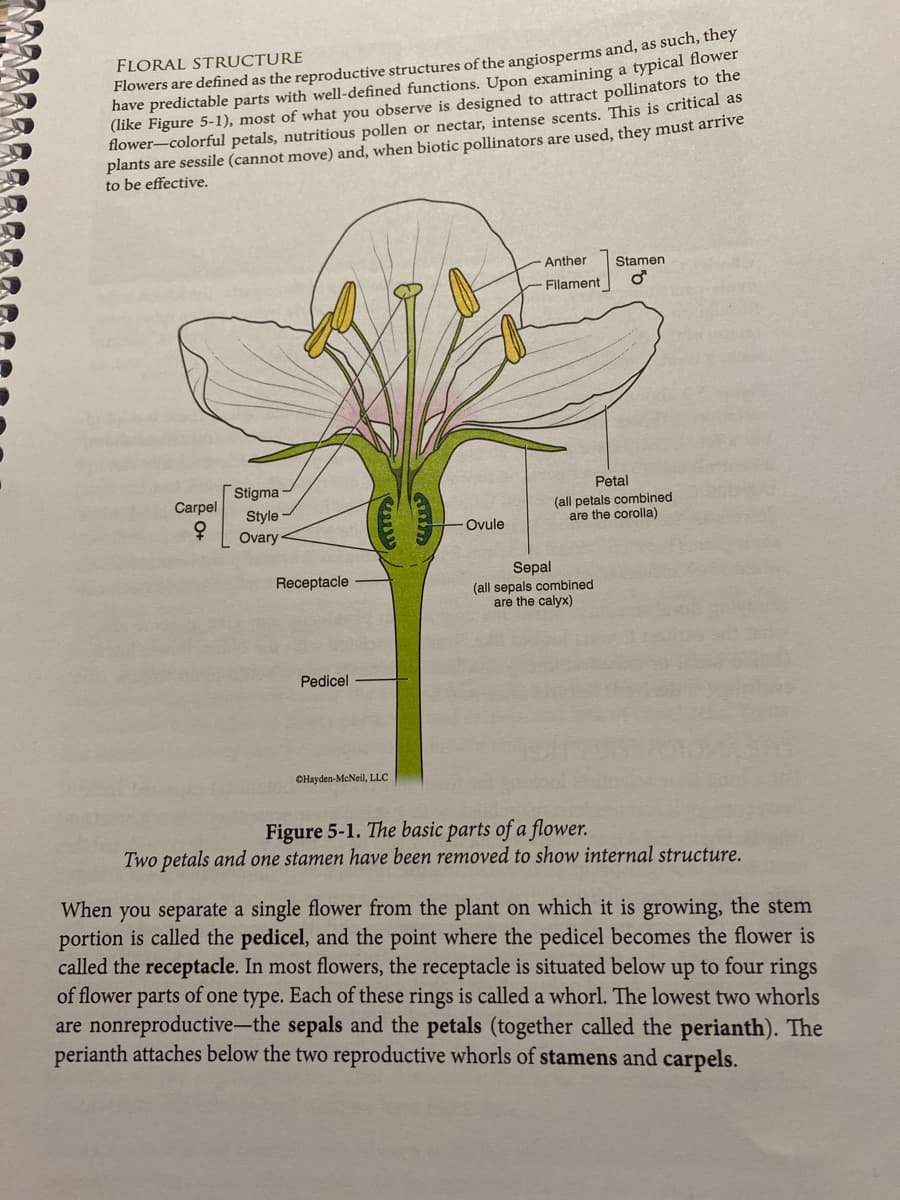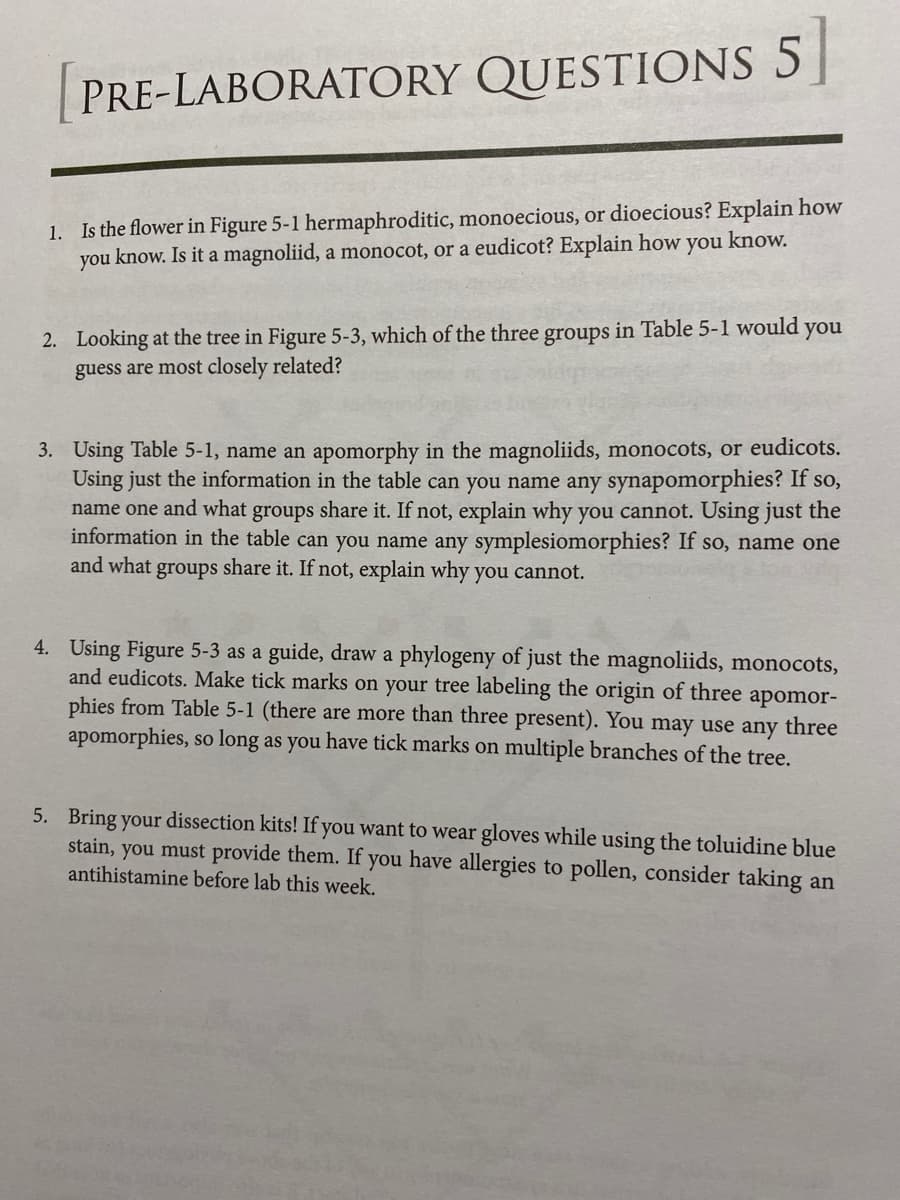1. Is the flower in Figure 5-1 hermaphroditic, monoecious, or dioecious? Explain how you know. Is it a magnoliid, a monocot, or a eudicot? Explain how you know.
1. Is the flower in Figure 5-1 hermaphroditic, monoecious, or dioecious? Explain how you know. Is it a magnoliid, a monocot, or a eudicot? Explain how you know.
Biology: The Dynamic Science (MindTap Course List)
4th Edition
ISBN:9781305389892
Author:Peter J. Russell, Paul E. Hertz, Beverly McMillan
Publisher:Peter J. Russell, Paul E. Hertz, Beverly McMillan
Chapter36: Reproduction And Development In Flowering Plants
Section: Chapter Questions
Problem 1ITD
Related questions
Topic Video
Question
1

Transcribed Image Text:Flowers are defined as the reproductive structures of the angiosperms and, as such, they
have predictable parts with well-defined functions. Upon examining a typical nower
(like Figure 5-1), most of what you observe is designed to attract pollinators to the
flower-colorful petals, nutritious pollen or nectar, intense scents. This is critical as
plants are sessile (cannot move) and, when biotic pollinators are used, they must arrive
to be effective.
FLORAL STRUCTURE
Anther
Stamen
Filament
Stigma
Petal
(all petals combined
are the corolla)
Carpel
Style
Ovule
Ovary
Sepal
(all sepals combined
are the calyx)
Receptacle
Pedicel
CHayden-McNeil, LLC
Figure 5-1. The basic parts of a flower.
Two petals and one stamen have been removed to show internal structure.
When you separate a single flower from the plant on which it is growing, the stem
portion is called the pedicel, and the point where the pedicel becomes the flower is
called the receptacle. In most flowers, the receptacle is situated below up to four rings
of flower parts of one type. Each of these rings is called a whorl. The lowest two whorls
are nonreproductive-the sepals and the petals (together called the perianth). The
perianth attaches below the two reproductive whorls of stamens and carpels.

Transcribed Image Text:PRE-LABORATORY QUESTIONS 5
1. Is the flower in Figure 5-1 hermaphroditic, monoecious, or dioecious? Explain how
you know. Is it a magnoliid, a monocot, or a eudicot? Explain how you know.
2. Looking at the tree in Figure 5-3, which of the three groups in Table 5-1 would
guess are most closely related?
you
3. Using Table 5-1, name an apomorphy in the magnoliids, monocots, or eudicots.
Using just the information in the table can you name any synapomorphies? If so,
name one and what groups share it. If not, explain why you cannot. Using just the
information in the table can you name any symplesiomorphies? If so, name one
and what groups share it. If not, explain why you cannot.
4. Using Figure 5-3 as a guide, draw a phylogeny of just the magnoliids, monocots,
and eudicots. Make tick marks on your tree labeling the origin of three apomor-
phies from Table 5-1 (there are more than three present). You may use any three
apomorphies, so long as you have tick marks on multiple branches of the tree.
5. Bring your dissection kits! If you want to wear gloves while using the toluidine blue
stain, you must provide them. If you have allergies to pollen, consider taking an
antihistamine before lab this week.
Expert Solution
This question has been solved!
Explore an expertly crafted, step-by-step solution for a thorough understanding of key concepts.
This is a popular solution!
Trending now
This is a popular solution!
Step by step
Solved in 3 steps with 2 images

Knowledge Booster
Learn more about
Need a deep-dive on the concept behind this application? Look no further. Learn more about this topic, biology and related others by exploring similar questions and additional content below.Recommended textbooks for you

Biology: The Dynamic Science (MindTap Course List)
Biology
ISBN:
9781305389892
Author:
Peter J. Russell, Paul E. Hertz, Beverly McMillan
Publisher:
Cengage Learning


Biology: The Dynamic Science (MindTap Course List)
Biology
ISBN:
9781305389892
Author:
Peter J. Russell, Paul E. Hertz, Beverly McMillan
Publisher:
Cengage Learning
